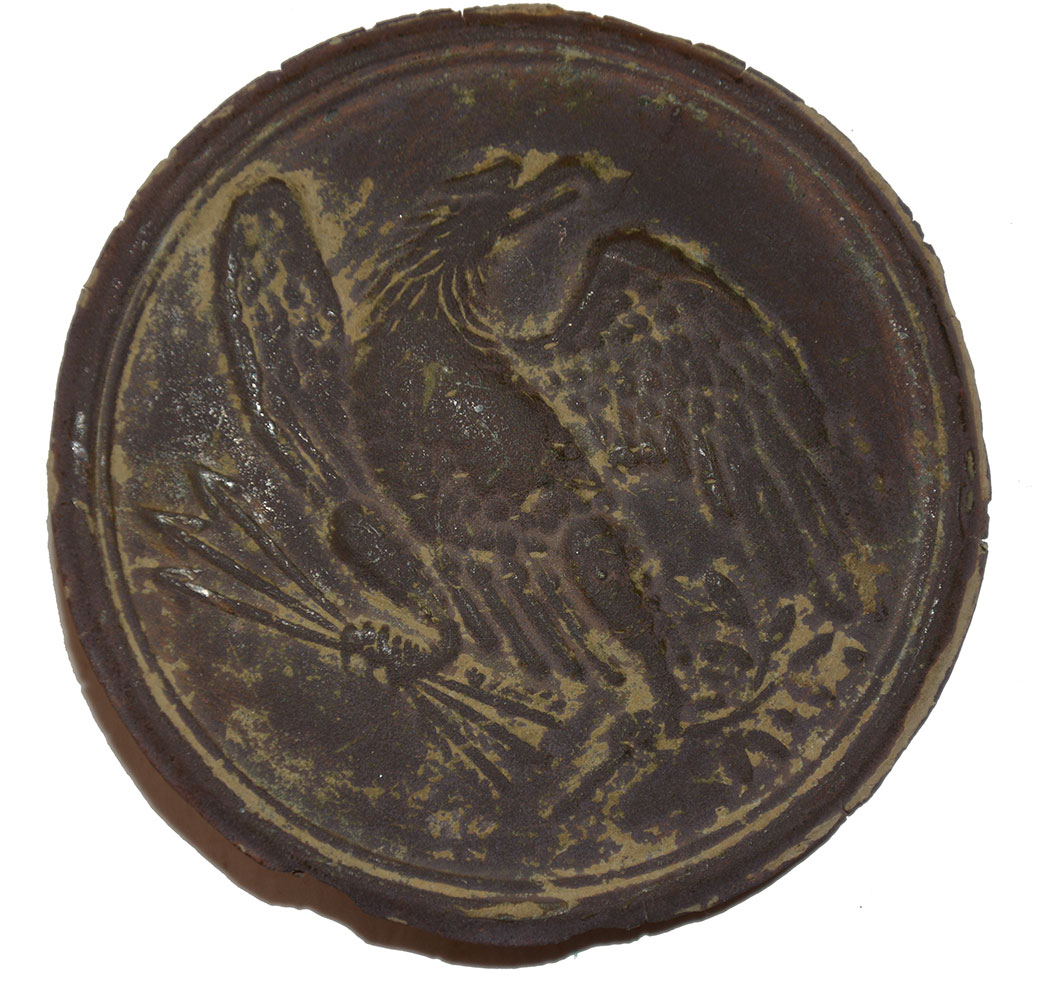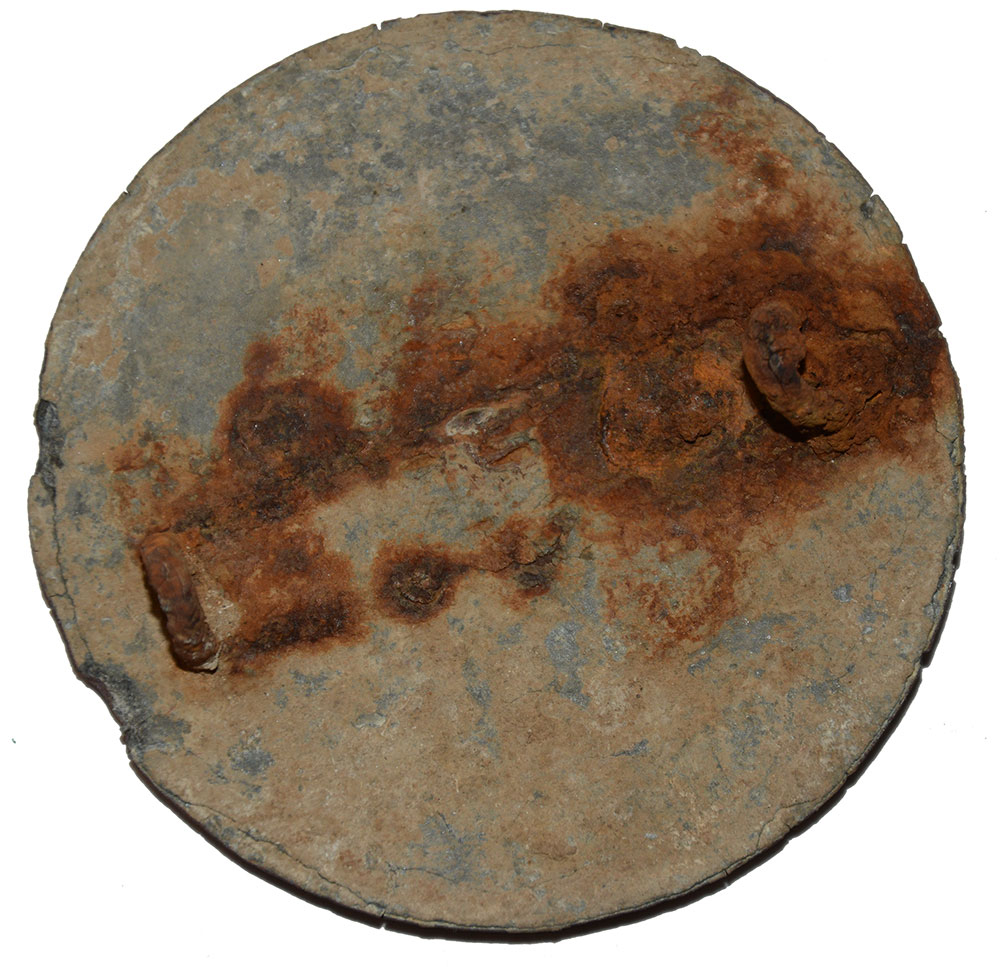site search
online catalog
BATTLE OF FRANKLIN CIVIL WAR EAGLE CARTRIDGE BOX BREAST PLATE

Hover to zoom


$215.00 SOLD
Quantity Available: None
Item Code: 490-5807
This is the regulation US plate worn on the infantry cartridge box sling and was recovered at Franklin, Tennessee, the site of Hood’s disastrous attack on the troops of Gen. John M. Schofield on Nov. 30, 1864. Made of stamped rolled brass, these plates bore a raised US eagle on the face and had a lead solder filled back to secure an iron wire bent to form two loops that pass through narrow slits in the leather cartridge box sling to be secured by a thong.
The face is a medium brown in color with light brown showing in recesses around the raised details of the eagle and inner border line. The detailing of the eagle is good and sharp. The outer rim of the plate shows a number of small, narrow and shallow nicks, mostly at top and right, with two broader dings at bottom. The reverse has a level solder fill showing gray and white with brown staining from oxidation of the iron wire, with the loops themselves gone. The two dings to the edge chipped out small bits of the fill and produced a hairline crack near the edge, but the rest of the fill is good, level, and stable.
This pattern was first adopted in 1826 with hooks on the reverse for the bayonet shoulder belt and made of stamped rolled brass for artillery and white metal for infantry. This was changed to brass for both services in 1831 and when the bayonet was moved to the waist belt around 1842 the plate was redesigned with two loops on the back for wear in a fixed position on the cartridge box sling. They were made by a number suppliers during the war. See O’Donnell and Campbell, American Military Belt Plates, pages 274 ff., for a thorough discussion of its development, production, variations, etc. They were finally replaced by the introduction of the 1872 accouterments, though few would have been made after 1865.
This is an interesting relic of a key battle in the west. After Sherman headed off on the March to the Sea, Hood tried to destroy in detail the forces he had left behind and Schofield was moving to join Thomas at Nashville. Schofield had successfully gotten by Hood at Spring Hill and Hood this time decided on a direct assault on Schofield’s lines ringing the south side of Franklin. He had some initial success in driving in some badly placed advanced Federal troops, even breaking into Schofield’s main line, but was stalled by Federal counterattacks in fierce, close-in fighting well remembered by soldiers on both sides. Hood’s attack has been compared with Pickett’s Charge in the number of casualties and lack of success, though some Confederates claimed it as victory since Schofield withdrew the next day, but it was far more damaging to Hood’s army in the loss to its leadership, six generals killed or mortally wounded alone, and morale. Schofield succeeded in joining Thomas, who counterattacked at Nashville about two weeks later. [SR] [PH:L]
~~~~~~~~~~~~~~~~~~~~~~~~~~~~~~~~~~~
THIS ITEM, AS WITH ALL OTHER ITEMS AVAILABLE ON OUR WEB SITE,
MAY BE PURCHASED THROUGH OUR LAYAWAY PROGRAM.
CLICK HERE FOR OUR POLICIES AND TERMS.
THANK YOU!
Inquire About BATTLE OF FRANKLIN CIVIL WAR EAGLE CARTRIDGE BOX BREAST PLATE
Most Popular
Historical Firearms Stolen From The National Civil War Museum In Harrisburg, Pa »
Theft From Gravesite Of Gen. John Reynolds »
Selection Of Unframed Prints By Don Troiani »
Fine Condition Brass Infantry Bugle Insignia »
Large English Bowie Knife With Sheath 1870’S – 1880’S »
Imported (Clauberg) Us Model 1860 Light Cavalry Officer's Saber »
featured item
FROCK COAT, SASH, EPAULETS AND SWORD BELT OF COLONEL AND BREVET BRIGADIER GENERAL ELI HOUSTON MURRAY, 3rd KENTUCKY CAVALRY
This set consists of a wonderful, identified Union cavalry colonel’s frock coat, epaulets, sash and sword belt, all in excellent condition and belonging to Col. E.H. Murray, 3rd Kentucky Cavalry, who saw action in Kentucky, Mississippi, Alabama,… (1268-783). Learn More »


